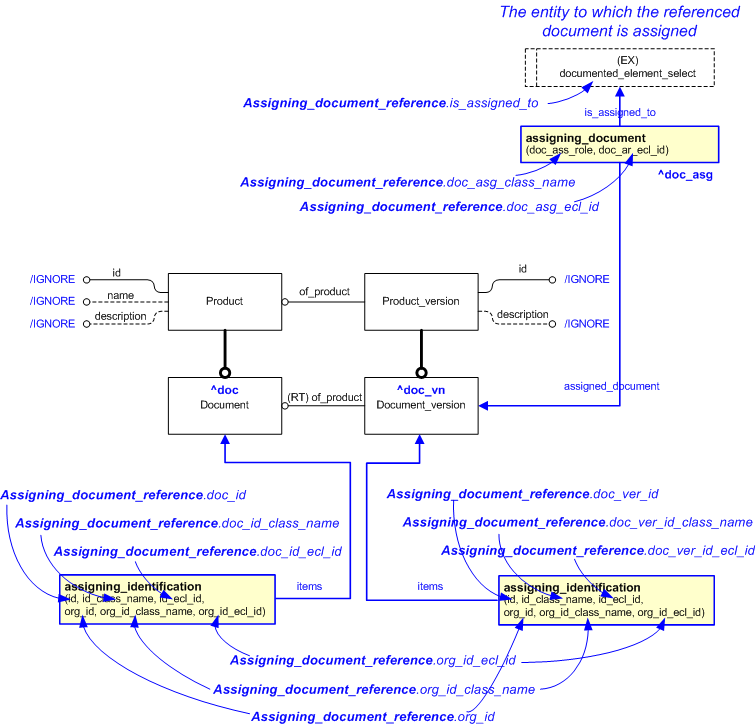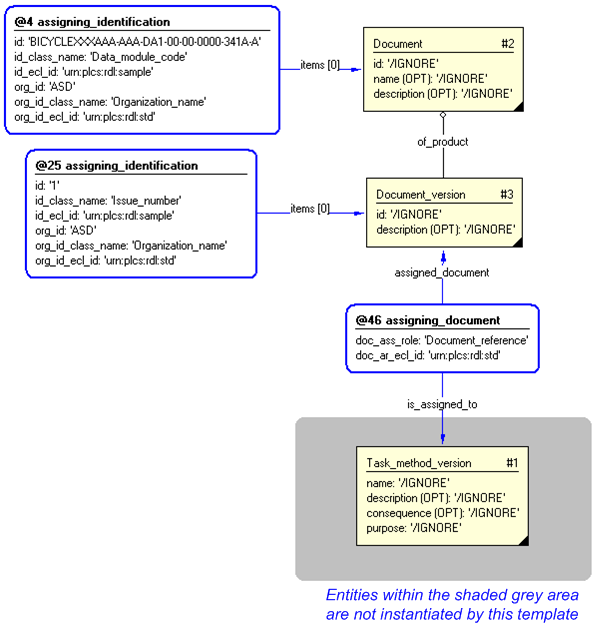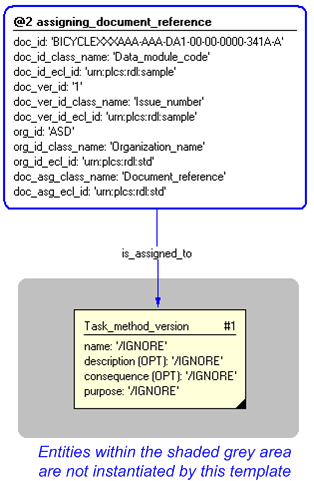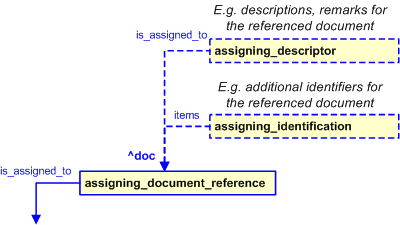Template:— assigning_document_reference (asg_doc_ref)
Capability:representing_documents |
Date: 2010/01/28 15:27:38
Revision: 1.12
|
This section specifies the template assigning_document_reference.
NOTE
The template has been defined in the context of the capability
representing_documents
which provides an overall description of the
relevant parts of the ISO 10303-239 information model and a description
of related templates.
NOTE
An explanation of a template and the associated instantiation path is
provided in the
Template overview
section.
This template describes how to represent a reference to a version of a document.
NOTE
Reference to a document where the version is not known (of not of interest), shall follow the guidelines described in the
template assigning_identification.
The EXPRESS-G diagram in
Figure
1
shows the templates and EXPRESS entities that are required
to represent the template
"assigning_document_reference".
The text highlighted in blue shows the template parameters.
Figure 1 — An EXPRESS-G representation of the Information model for assigning_document_reference
The graphic for the template to be used in other EXPRESS-G diagrams
is shown in Figure
2
below.
Figure 2 — The graphical representation of the assigning_document_reference template
The following input parameters are defined for this template:
The identification of the
Document
being referenced.
The name of the
External_class that determines the type of identifier given by the
input parameter @doc_id.
The following classes and their sub-classes can be used:
The name of the
External_class that determines the type of identifier given by the
input parameter @doc_ver_id.
The following classes and their sub-classes can be used:
The name of the
External_class that determines
the type of organization identification (@org_id) being used. For example CAGE code.
The following classes and their sub-classes can be used:
The following classes and their sub-classes can be used:
The items to which the referenced document is assigned.
The following reference parameters are defined for this template:
Allow the
Document
entity instantiated in this path to be referenced when this template is used.
Note: The
Document
entity can be referenced in a template path by:
%^target = $assigning_document_reference.doc%
where
target
is the parameter to which the
Document
is bound.
Allow the
Document_version
entity instantiated in this path to be referenced when this template is used.
%^target = $assigning_document_reference.doc_vn%
Allow the
Document_assignment
entity instantiated in this path to be referenced when this template is used.
%^target = $assigning_document_reference.doc_asg%
The following parameter combinations specify a uniqueness constraint:
Unique constraint: Unique document
This rule means that there can be only one document
(
Document)
with any given identifier.
Unique constraint: Unique document version
This rule means that there can be only one version
(
Document_version)
of a document
(
Document)
with any given identifier.
The instantiation path shown below specifies the entities that are to be
instantiated by the template.
A description of templates and the syntax for the instantiation path is
provided in the
Templates Help/Information section.
Document-- Mark the Document entity as -- referable when this template is used by binding it to the reference -- parameter doc %^doc =
Document%
Document.id = '/IGNORE'
Document.name = '/IGNORE'
Document.description = '/IGNORE'
-- assign the identification to the Document /
assigning_identification(
items=^doc,
id=@doc_id,
id_class_name=@doc_id_class_name,
id_ecl_id=@doc_id_ecl_id,
org_id=@org_id,
org_id_class_name=@org_id_class_name,
org_id_ecl_id=@org_id_ecl_id)/
-- Mark the Document_version entity as -- referable when this template is used by binding it to the reference -- parameter doc_vn Document_version%^doc_vn =
Document_version%
Document_version.id = '/IGNORE'
Document_version.description = '/IGNORE'
Document_version.of_product ->
^doc
-- assign the identification to the Document_version /
assigning_identification(
items=^doc_vn,
id=@doc_ver_id,
id_class_name=@doc_ver_id_class_name,
id_ecl_id=@doc_ver_id_ecl_id,
org_id=@org_id,
org_id_class_name=@org_id_class_name,
org_id_ecl_id=@org_id_ecl_id)/
-- assign the referenced document to the entity given by the -- input parameter @is_assigned_to -- and classify it as 'Document_reference' or subtype thereof /
assigning_document(
assigned_document=^doc_vn,
is_assigned_to=@is_assigned_to,
doc_ass_role=@doc_asg_class_name,
doc_ar_ecl_id=@doc_asg_ecl_id)/
-- Mark the Document_assignment entity in the template assigning_document as -- referable when this template is used by binding it to the reference -- parameter doc_asg %^doc_asg = $assigning_document.doc_asg%
The following entities are instantiated with attributes as specified:
The instance diagram in Figure
3
shows an example of the EXPRESS entities and templates that are instantiated by the template:
/assigning_document_reference(doc_id='BICYCLEXXXAAA-AAA-DA1-00-00-0000-341A-A', doc_id_class_name='Data_module_code', doc_id_ecl_id='urn:plcs:rdl:sample', doc_ver_id='1', doc_ver_id_class_name='Issue_number', doc_ver_id_ecl_id='urn:plcs:rdl:sample', org_id='ASD', org_id_class_name='Organization_name', org_id_ecl_id='urn:plcs:rdl:std', doc_asg_class_name='Document_reference', doc_asg_ecl_id='urn:plcs:rdl:std', is_assigned_to='#1')/
(an illustration of the consolidated assigning_document_reference template is shown in
Figure
4 below.)
Figure 3 — Entities instantiated by assigning_document_reference template
The instance model in STEP ASCII exchange file format (ISO 10303 Part
21 syntax) is:
#1 = TASK_METHOD_VERSION('/IGNORE','/IGNORE','/IGNORE','/IGNORE',$,$);
#2 = DOCUMENT('/IGNORE','/IGNORE','/IGNORE');
#3 = DOCUMENT_VERSION('/IGNORE','/IGNORE',#2);
#5 = IDENTIFICATION_ASSIGNMENT('BICYCLEXXXAAA-AAA-DA1-00-00-0000-341A-A','/IGNORE',$,(#2));
#7 = CLASSIFICATION_ASSIGNMENT(#8,(#5),'/IGNORE');
#8 = EXTERNAL_CLASS('/NULL','Data_module_code','/IGNORE',#9);
#9 = EXTERNAL_CLASS_LIBRARY('urn:plcs:rdl:sample','/IGNORE');
#12 = ORGANIZATION('/IGNORE','/IGNORE');
#14 = IDENTIFICATION_ASSIGNMENT('ASD','/IGNORE','/IGNORE',(#12));
#16 = CLASSIFICATION_ASSIGNMENT(#17,(#14),'/IGNORE');
#17 = EXTERNAL_CLASS('/NULL','Organization_name','/IGNORE',#18);
#18 = EXTERNAL_CLASS_LIBRARY('urn:plcs:rdl:std','/IGNORE');
#20 = ORGANIZATION_OR_PERSON_IN_ORGANIZATION_ASSIGNMENT(#12,'/IGNORE',(#5,#26));
#22 = CLASSIFICATION_ASSIGNMENT(#23,(#20),'/IGNORE');
#23 = EXTERNAL_CLASS('/NULL','Owner_of','/IGNORE',#18);
#26 = IDENTIFICATION_ASSIGNMENT('1','/IGNORE',$,(#3));
#28 = CLASSIFICATION_ASSIGNMENT(#29,(#26),'/IGNORE');
#29 = EXTERNAL_CLASS('/NULL','Issue_number','/IGNORE',#9);
#47 = DOCUMENT_ASSIGNMENT(#3,#1,'/IGNORE');
#49 = CLASSIFICATION_ASSIGNMENT(#50,(#47),'/IGNORE');
#50 = EXTERNAL_CLASS('/NULL','Document_reference','/IGNORE',#18);
The instance diagram in
Figure
4
shows the graphic symbol for the template that is to be
used in other instance diagrams. The example template is:
/assigning_document_reference(doc_id='BICYCLEXXXAAA-AAA-DA1-00-00-0000-341A-A', doc_id_class_name='Data_module_code', doc_id_ecl_id='urn:plcs:rdl:sample', doc_ver_id='1', doc_ver_id_class_name='Issue_number', doc_ver_id_ecl_id='urn:plcs:rdl:sample', org_id='ASD', org_id_class_name='Organization_name', org_id_ecl_id='urn:plcs:rdl:std', doc_asg_class_name='Document_reference', doc_asg_ecl_id='urn:plcs:rdl:std', is_assigned_to='#1')/
Figure 4 — Instantiation of assigning_document_reference template
The following section details how the
assigning_document_reference
template can be optionally characterized by assigning
other constructs to it. These are characterizations commonly
applied to the template. The ISO 10303-239 EXPRESS model may enable
other assignments to the entities instantiated by the template.
The EXPRESS-G diagram in Figure
5
shows the possible characterizations of the template
"assigning_document_reference".
Figure 5 — Possible characterizations of the referenced document.
The following characterizations may apply:
Characterization Assigning identification
NOTE this characterization is optional.
Characterization Assigning descriptor
NOTE this characterization is optional.





